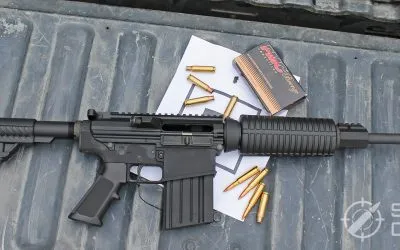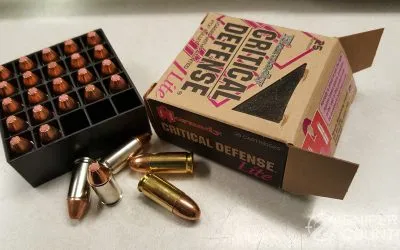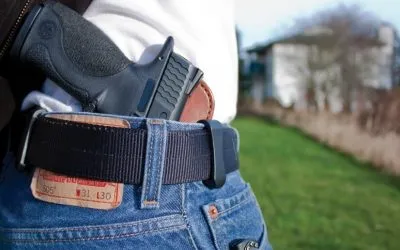
10mm in a 1911?
This was my first real experience with a 1911 10mm (read my best 1911 comparison here) and I was a bit curious as to what was going to happen.

Is There A More Forgiving Platform?
Not having shot a lot of 10mm through a Glock or an EAA Witness with polymer frames, I can only imagine the difference. With the stainless steel 1911 frame and its non-flexing-characteristics, I figured the 10mm would probably be a handful. I’ll talk more about this specific gun later, but first let’s talk about current production guns and how they’re built.
Colt’s Current Delta Elite
The Colt Delta Elite (DE) 10mm 1911 was the gun that really helped put Colt back on the “map” of gunmakers and almost single-handedly saved the 10mm cartridge. These are strong statements, but I think that they are true to a certain extent. First, Colt was not exactly teetering on the edge of collapse – nothing as apocryphal as that – but their sales in the latter part of the 1980s were not all that could be hoped for. The second part of the statement is a little easier to “prove”, if that’s the right word. The only other 10mm gun around at that time (ca. 1986) was the Dornhaus & Dixon/Jeff Cooper Bren Ten that had been introduced in 1983. That was the first pistol to fire what became the 10mm cartridge, but had its share of production issues that led to its demise. (For an overall look at 10mm guns, check out my article on that topic here). Colt was the first major, mainstream gun manufacturer to put a 10mm into production.BONUS OFFER: Get your free shooting range targets to print at home!
Get your free targets to print at home!
A Bit Of History
I always like to know the backstory of things, be they old movies, warplanes or guns and ammo. It makes for interesting reading (hopefully!). The road that the DE has traveled is fairly long, with some potholes along the way. The gun was first introduced in 1987. Named for the famous Delta Force (1st Operational Special Forces Detachment-Delta) of the U.S. Army, Colt set the bar high for the gun. As stated above, it was only the second 10mm pistol to be put into production, and then became the only one going after D&D went out of business. The gun was made in a few variations until 1996, when it was discontinued due to lack of sales, coupled with the availability of smaller guns with greater capacity in .40 S&W. The 10mm cartridge had not caught on with shooters at that time, but that would change. It didn’t help that the F.B.I. dropped the 10mm in favor of the .40 S&W. It is interesting to note that the original DEs experimented with a bushingless system for the barrel/slide lockup. This didn’t last very long due to so-so accuracy, and the gun’s design was returned to the traditional barrel/bushing system soon afterwards. The gun was re-introduced on March 31st, 2009. It was a better seller than it had been before, as shooters were discovering the advantages of the 10mm round for hunting and defense. (A full-charge 10mm load can deliver energy levels approaching a .41 Magnum). This made the DE into a pretty popular deer and hog gun, among other uses.
The gun was re-introduced on March 31st, 2009. It was a better seller than it had been before, as shooters were discovering the advantages of the 10mm round for hunting and defense. (A full-charge 10mm load can deliver energy levels approaching a .41 Magnum). This made the DE into a pretty popular deer and hog gun, among other uses.

Variations
At last count, I discovered twelve variations of the DE, starting from its introduction through current production. Variations include guns made from carbon steel and blued, stainless steel, different sight configurations, different dust covers, and other changes. There were even a run of Gold Cup National Match models made – that's the one I shot.For a more detailed list of those variations, check this information out. There was even a version made for a distributor that included parts so as to enable the .40 S&W to be fired, in addition to 10mm. We see that there were several variations made over the years, which leads us to the present-day DE. The Colt web page now shows just two models – the standard stainless 1911 model and one with a rail underneath for mounting a light, although the Lew Horton distribution company shows a two-tone model available. This gun is offered in a two-tone black Ion Bond Slide coupled with a stainless frame. This is not shown on Colt’s site, but it shows up for sale on internet seller sites. Now is a good time to look at the specifications for the DE – these were taken from Colt’s web site and other sources.| Length | 8.3 inches |
| Height | 5.7 inches |
| Width | 1.26 inches |
| Weight | 35.9 ounces empty |
| Barrel Length | 5 inches |
| Action | Single Action |
| Capacity | 8 + 1 |
| Finish | stainless steel |
| Grips | black composite with Delta medallion |
| Sights | Novak white dot front, Novak Low Mount Carry, rear |
| Safeties | thumb, grip, Series 80 firing pin |
| Features | upswept beavertail with Commander-style rowel hammer; 3-hole aluminum trigger, extended thumb safety, 23# double recoil spring; two 8-round mags |
Popular Articles
The Battered Frame Syndrome
A few of the early DEs were prone to flex-induced slide rail stress cracks at the slide stop cutout, as the early DEs had a “bridge” of metal over that cutout. The frame would suffer stress-induced cracks at one end of it or the other. The solution was to remove that segment of metal above the cutout, which allowed the frame to absorb more of the rather-hefty recoil forces. To reiterate, this was a problem in the very beginning of the DE’s production run and was solved pretty quickly. They simply removed the section of metal above the slide stop cutout so it couldn’t crack. They’re made this way today, with that section removed. Here’s a shot of the gun I shot, from the inside...you can clearly see that the frame has the cutout, right above the end of the slide stop:
Optional: Shock Buffers
Another issue that crops up with some pistols is the need to use shock buffers to help protect the frame from slide battering. Although this is not a factory issue, as the frame cut above was, it is still an issue for some shooters. This is not only a 10mm 1911 issue...buffers have been used for many years with .45 ACP pistols. Some 10mm shooters use them as cheap “insurance“ against frame damage. My friend who loaned me this very early (S/N under 3000) DE told me he’s gone through three buffers, and he doesn’t get a lot of free time to shoot. Now...that doesn’t mean that if you are not using these buffers you are hurting your pistol. It’s like I said above, some shooters just use them to guard against possible frame-battering issues. Here’s what one brand looks like: These are molded from poly fiber and are 1/10 inch thick. The cost on the website where I found these was under $7 for the six of them. That‘s why I used the term “cheap” above. Shoot the gun until the buffer is worn, then swap it out for a new one. How? Slide the recoil spring off its guide rod and push the buffer all the way to the rear end of the rod, then reinstall the spring and put it back in the gun. Pretty simple, and they will work to lessen the impact of the reciprocating slide against the frame. (One video I saw had the gunsmith tell us to “put the writing on the buffer towards the back”, although I’m not sure what beneficial effect that would have).
These are molded from poly fiber and are 1/10 inch thick. The cost on the website where I found these was under $7 for the six of them. That‘s why I used the term “cheap” above. Shoot the gun until the buffer is worn, then swap it out for a new one. How? Slide the recoil spring off its guide rod and push the buffer all the way to the rear end of the rod, then reinstall the spring and put it back in the gun. Pretty simple, and they will work to lessen the impact of the reciprocating slide against the frame. (One video I saw had the gunsmith tell us to “put the writing on the buffer towards the back”, although I’m not sure what beneficial effect that would have).
Guide Rod
 DE guide rods are made from a durable plastic substance called Delrin, a high-quality compound made originally for the medical industry. Colt’s thinking on this (as far as I can tell – they didn’t consult with me) was that the short guide rod was plenty strong enough for the task at hand but would flex to help absorb recoil and would break before the gun broke in the event of an “issue” or just plain wear. Some folks thought that the rod should be metal, so they replaced them, as is the case of the one I borrowed. Unless you have issues with the guide rod, the Delrin rod and two-spring setup seems to work as advertised (from what I could find and from talking with folks who owned them).
DE guide rods are made from a durable plastic substance called Delrin, a high-quality compound made originally for the medical industry. Colt’s thinking on this (as far as I can tell – they didn’t consult with me) was that the short guide rod was plenty strong enough for the task at hand but would flex to help absorb recoil and would break before the gun broke in the event of an “issue” or just plain wear. Some folks thought that the rod should be metal, so they replaced them, as is the case of the one I borrowed. Unless you have issues with the guide rod, the Delrin rod and two-spring setup seems to work as advertised (from what I could find and from talking with folks who owned them).
My Personal Experience With The DE Gold Cup
I do not own a DE, but was able to borrow one from my above-mentioned friend. He has a very early model (as I said, the S/N is under 3000), so if there were to be any shenanigans with frame cracking or whatever, this gun would be a candidate. All has been good with this gun since he bought it – no frame problems (or any other problems, for that matter). He does use frame buffers in his gun.Gold Cup Delta
 This particular gun was made in 1990, according to Colt’s serial number lookup. It has several features that the current production models do not have...first off, it’s a Gold Cup. What does that mean? Gold Cups are top-end target 1911s that Colt has made for many years. They have adjustable rear sights (Millet, in this case). a flat-topped, square-faced target front sight, a National Match barrel, and (in the case of the .45 versions) some really nice a-cut-above grips. The internals are polished, and the action is tuned. They are truly fine guns. Colt introduced a Delta Elite version Gold Cup for target work, but I’d bet it saw (or sees) a lot of hunting action as well. The original Gold Cups were used in bullseye competition and were very accurate out to 50 yards with the shooter’s pet handload. I have a friend whose dad owned an older Gold Cup and I believe he has it now. I’ve shot it – what a sweet-shooting pistol!
This particular gun was made in 1990, according to Colt’s serial number lookup. It has several features that the current production models do not have...first off, it’s a Gold Cup. What does that mean? Gold Cups are top-end target 1911s that Colt has made for many years. They have adjustable rear sights (Millet, in this case). a flat-topped, square-faced target front sight, a National Match barrel, and (in the case of the .45 versions) some really nice a-cut-above grips. The internals are polished, and the action is tuned. They are truly fine guns. Colt introduced a Delta Elite version Gold Cup for target work, but I’d bet it saw (or sees) a lot of hunting action as well. The original Gold Cups were used in bullseye competition and were very accurate out to 50 yards with the shooter’s pet handload. I have a friend whose dad owned an older Gold Cup and I believe he has it now. I’ve shot it – what a sweet-shooting pistol!
 OK...back to my experience...I was handed the pistol box by my friend and was told to keep it however long I needed it and to adjust the rear sight if necessary (which I will not do). He told me, in the store (he has a gun safe right behind his desk and it isn’t a gun store), that he had replaced some parts and had some work done to the gun. I asked what had been altered, and he said:
OK...back to my experience...I was handed the pistol box by my friend and was told to keep it however long I needed it and to adjust the rear sight if necessary (which I will not do). He told me, in the store (he has a gun safe right behind his desk and it isn’t a gun store), that he had replaced some parts and had some work done to the gun. I asked what had been altered, and he said:
- Action job
- Replaced recoil guide rod/spring with stainless steel rod and...get this...a 28-pound spring
- Other internals polished
- Overtravel trigger stop installed
The Spring’s The Thing
The spring thing was a killer for me. I recently injured a finger, and with my arthritic hands, could barely rack the slide to chamber a round. I knew there was no way I was going to break it down for cleaning/photography and then be able to get the recoil spring, plug and barrel bushing back in place, so that explains the lack of internal parts photos...that spring makes the slide a … well, insert your favorite naughty word here... to rack. To my old hands, it’s about like having a car suspension spring in there. I do think the factory ones come with a 23-pound spring, if I’m not mistaken. This 28-pounder should allow you to shoot anything in 10mm short of howitzer shells and not batter the frame. Alright – I get eight PMC rounds in the mag, get it seated past the mag well he’d installed (no bumper pads – these mags do not come with those), and get the chamber loaded. I “pull down” as they used to say on the target, line up the sights, sign my last will & testament and pull the trigger...and pull hard...and pull...nothing. Long story short, the overtravel stop was screwed out too far. I screwed it in a turn or two, dry-fired, and “click” as the hammer dropped. So...back to the bench...BONUS OFFER: Get your free shooting range targets to print at home!










![9mm Glock Models [Ultimate Guide]](https://snipercountry.com/wp-content/uploads/2018/10/Glock-17-vs-Glock-19-vs-Glock-26-vs-Glock-41-vs-Glock-43-WM-400x250.webp)
![Handgun Caliber Chart [2025 Ultimate Guide]](https://snipercountry.com/wp-content/uploads/2018/10/Handgun-Caliber-Comparison-400x250.webp)
![Rifle Calibers [Ultimate Guide]](https://snipercountry.com/wp-content/uploads/2018/12/Header-1900-400x250.webp)







7 Responses
Why buy this when Glock holds 15 instead of 8 rounds..
because it is a COLT and not a glock
Colt DE was the first handgun I ever bought. I shot a lot of ammo out of it, and it got me into handloading, too, (it gave me a chance to learn a lot about loads) because back in the late ’80s commercial 10mm was very pricey. They’re still not cheap, but proportionately cheaper than they used to be.
Shot my first two deer with it. I still have one, but I’ve tricked it out a bit.
Very good work! ?? Kongrat Mike!
bought one in Montana when they first came out, waited two months before I could find ammo, took up reloading and shot thousands of rounds in that shooter. That Colt got away from me in 92 in Alaska. Found another early model in mint condition up around Fairbanks in 2019. These days I lean to using a long slide Springfield 1911 in 460 Rowland, its gotta a lot more snap to it, the ten is handy but the Rowland is a dandy.
Just pick one of these up from Buds Gun Shop, the railed model and thanks for your review
I greatly enjoyed your review of the DE. I have been doing some research that the DE and the 10mm round are directly in the middle of. Can you tell me of any long gun that would have shot the same round pre 1990, and was the DE available to the general public pre 1990? I understand that the FBI started carrying it in 1989 and some competition shooters were using it. Thanks for sharing your knowledge with me.